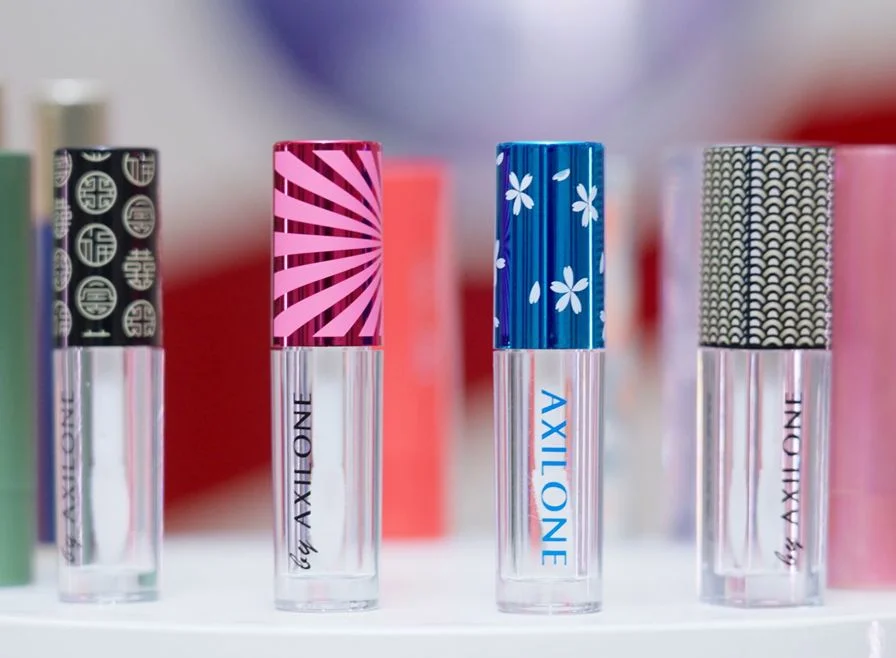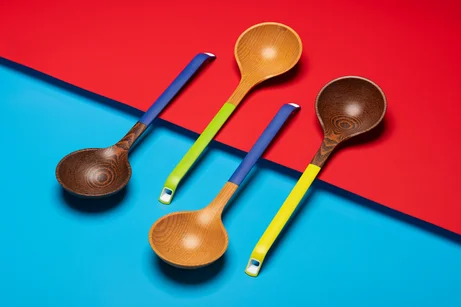Have you ever picked up a 3D print and had to do a double take? That’s the power of full-color 3D printing - it blends realism, brand accuracy, and tactile design into a single, seamless build.
So what exactly is the difference between color 3D printing, multi-color 3D printing, and true full-color 3D printing? Can one machine do it all? And which technology fits your application?
This article aims to answer all your questions about 3D printing in color - and show you what’s possible with industrial-standard full-color 3D printing from Stratasys.
Full-color 3D printing and multi-color 3D printing are often used interchangeably, but if we’re being accurate, there is a difference.
Full-color 3D printing colors a base material as it prints (just like your CMYK 2D desktop printer), creating photo-realistic parts with subtle color gradients, textures, and branding accuracy. In fact, full-color 3D printing blends CMYKW (Cyan, Magenta, Yellow, Black, and White) materials in fine layers to produce vivid, Pantone-accurate results. It’s ideal for consumer packaging prototypes, anatomical models, and anything that needs to look realistic.
By contrast, multi-color 3D printing uses pre-colored filaments or resins to create separate zones of color. There’s no blending - just clear, distinct color areas. This makes multi-color 3D printing ideal for fixtures, functional prototypes, and safety-critical components where visual clarity matters.
Whether you choose full-color 3D printing or multi-color 3D printing, the right choice depends on how your part needs to look, feel, and function.
Now that we’ve defined full-color 3D printing and multi-color 3D printing, let’s look at the technologies behind them - and how each handles 3D color printing differently.
When you need your prototype to look and feel like the final product, full-color 3D printing with Stratasys PolyJet delivers. It’s the only Stratasys technology that blends CMYKW photopolymers voxel by voxel - producing lifelike gradients, crisp labels, and Pantone®-accurate color output.
PolyJet doesn’t just create colorful objects - it prints CMF (Color, Material, Finish). You can simulate wood, rubber, leather, soft-touch grips, and transparent packaging in a single print job. It delivers full-color 3D printing that makes it ideal for industries like:
Pantone validation comes standard on J850 Prime, J826, and J55 Prime, while advanced medical realism is the focus of the J850 Digital Anatomy Printer. Even the entry-level J35 Pro supports multi-material printing for material contrast and clarity.
Whether you’re designing for realism or visual clarity, there are multiple ways to achieve color 3D printing results - and each one serves a different purpose. You may need full-color 3D printing or multi-color 3D printing, depending on what you need to build:
This is the most accessible form of multi-color 3D printing. 3D printers use pre-colored filaments or resins to produce solid-color parts or distinct zones - perfect for labels, safety indicators, and color-coded jigs – but you can’t print colored gradients or Pantone shades.
This is true full-color 3D printing - powered by PolyJet technology. With our Digital PolyJet Materials, the printer blends CMYKW materials voxel-by-voxel, letting you simulate subtle gradients, textures, and Pantone®-accurate branding in a single print. No painting needed.
Select PolyJet printers offer Pantone Validation™ support. With GrabCAD Print, you can assign from a range of 1,867 Pantone C (Coated) colors, plus approximately 110 officially supported Pantone SkinTone shades directly to your parts - and trust that your physical prototype will match the screen, the spec, and the shelf.
These are older, powder-based methods. They use a liquid binder and CMYK ink to create color 3D prints on gypsum-like powder. They produce flat, grainy parts that are fragile and easily damaged - better suited for figurines or display pieces than for real-world applications. We don’t offer these technologies for color 3D printing, because they simply can’t match the performance or finish required for serious prototyping.
These older methods still exist, but they’re fading fast. Full-color 3D printing eliminates the need for hand-painting or water-transfer graphics - saving time, labor, and inconsistency across iterations.
Designers aren’t just printing for fun - they’re trying to solve real challenges in product development. That means convincing stakeholders, replicating textures, simulating materials, testing how a product will look and feel in the real world - before it ever hits the factory floor.
Stratasys full-color 3D printing with PolyJet is built for that.
The Xbox accessories team used PolyJet and Pantone Validated™ colors to replicate translucent buttons, textured grips, screen layouts and more - all in one single build. This let them test the form, color and UI together without waiting for production tooling.
Using VeroUltra materials, designers printed entire packaging mockups - including the bottle, label, and fine details like barcodes and QR codes - all in one print. Sharp gradients, accurate brand colors, and lifelike textures made it easy to test and present packaging concepts faster and more clearly than ever.
Instead of painting or layering stickers by hand, designers used PolyJet and VeroUltra to print dolls with skin tones, facial features, and outfit details baked in. Every stakeholder saw the same version - making approvals faster and more accurate
Using translucent and opaque materials in one build, designers can simulate digital displays, illuminated buttons, or even test how materials look when backlit. PolyJet supports ultra-fine text and graphics that meet 2D print standards - making UI testing faster and more realistic than ever.
Axilone, supplier to Dior and Chanel, also used PolyJet full-color resin 3D printing to prototype luxury cosmetic packaging. Transparent caps, metallic textures, and color-accurate logos were all printed in a single job - no painting or assembly needed.

Kinetic Vision executives explain the importance of packaging design "on the edge of reality" using full color 3D printing:
Instead of painting, masking, or CNC machining wood parts, designers used Stratasys PolyJet™ with VeroUltra™ materials to 3D print a lifelike ladle in one job - complete with realistic wood texture and precise color matching. This cut out outsourcing, reduced error, and delivered consistent, high-quality, full-color 3D printing fast.

In medical applications, color isn’t about branding - it’s about clarity and communication. Stratasys PolyJet’s full-color 3D printing enables ultra-realistic models with multiple materials and shades - from soft tissue to bone, from gums to teeth.
Posca Brothers used the J5 DentaJet and TrueDent™ resin to produce multi-color resin 3D printing dentures in one job - including tooth shades, gum tones, and translucency.
In the world of wearable tech and couture design, Stratasys’ TechStyle™ 3D printer is enabling designers to print directly onto fabric - not just in full color, but with structure and flexibility.
“Looking at the fashion world today, I want to introduce a new way of manufacturing - moving away from mass production to customized design.” - Ganit Goldstein
From lighting to interiors, automotive teams rely on fast, accurate prototypes to align design and engineering - replicating gloss, transparency, and material contrast to validate color and finish before tooling, and presenting designs that feel final even at the prototype stage.
Whether you're printing lifelike packaging prototypes or bold functional tools, your material choice defines more than just color - it shapes how your part feels, flexes, and performs.
Here’s a breakdown of the most important color-capable materials across Stratasys PolyJet technologies:
Used in printers like the J850 Prime, J826, and J55, these materials support Pantone Validated™ color blending, multi-material combinations, and fine textural detail - making them ideal for prototypes that look (and feel) like the real thing.
|
Material |
Compatible Printers |
Key Traits |
|
J850 Prime, J826 Prime, J55 Prime, J5 MediJet, J5 DentaJet |
Enables CMYKW blending, Pantone Validated™, and vivid color gradients. |
|
|
J850 Prime, J826 Prime, J55 Prime, J850 Digital Anatomy |
Provides a bright base layer for high-contrast color output. |
|
|
J850 Prime, J826 Prime, J55 Prime |
Rubber-like flexibility; ideal for grips, buttons, ergonomic components |
|
|
J850 Digital Anatomy |
Simulate soft tissue, bone, and vasculature for clinical realism |
The human eye can perceive over 1 million distinct colors in what’s called the L*a*b* color space. But how close can a 3D printer get?
The addition of White (W) material is what separates CMYKW printing from traditional CMYK. It enables color vibrancy on translucent or clear bases - especially important when working with complex 3D geometries or transparent layers.
With PolyJet’s CMYKW color-blending system, you’re printing in high fidelity - not just for looks, but for measurable full-color 3D printing accuracy.
It’s a measure of the difference between two colors. A ΔE of 1 represents the smallest visible difference the human eye can detect. So when your prototype is under 2, you’re in hyperrealism territory - not approximation.
This precision means you can hit exact brand colors, simulate skin tones, and print color-critical models for packaging, medical, fashion, and consumer products.
This is what sets industrial full-color 3D printing apart from hobbyist tools. You’re not just printing in multiple colors - you’re printing accurate, photorealistic, functional color.
Even when color isn’t the star of the show, PolyJet helps your prototype feel closer to the final product. Thanks to Stratasys PolyJet’s exclusive Digital Materials, you can combine two or more base resins during the print to create unique combinations of color, flexibility, transparency, hardness, and texture - voxel by voxel:
Color + Transparency - Show internal structures or simulate glass with VeroClear
Color + Texture - Mimic leather, rubber, matte or gloss directly in the part
Color + Flexibility - Add soft-touch zones, grips or flexible details with Agilus30
These combinations make your model more than just a visual - they turn it into a convincing, tactile representation of the final product.
Before full-color 3D printing, realistic prototypes required hours of sanding, painting, and assembly. Every revision meant repeating the same post-processing steps. Even with access to multi-color 3D printing, it often meant printing in white and painting manually - increasing time, cost, and inconsistency.
|
The old way |
The Stratasys way |
|
|
The result? Faster approvals. Fewer errors. Lower costs. And more time for your team to design and iterate.
With so many options, how do you choose the right full color or multi-color 3D printer for your needs?
Start with the outcome. What do you want to achieve - photorealism, color-coded function, or something in between? Here's a simplified guide to help you find the best fit:
|
Printer |
Color Type |
Color Printing Method |
PANTONE Validated™ |
Highlights |
|
Full color |
Blends CMYKW photopolymers voxel-by-voxel |
Yes |
Supports 500K+ colors, Pantone C and SkinTone matching, gradients, textures, and material blends |
|
|
Full color |
Blends CMYKW photopolymers voxel-by-voxel |
Yes |
Over 640K colors, compact design, 5 materials per job |
|
|
Full color |
Blends CMYKW photopolymers voxel-by-voxel |
Yes |
Compact printer for medical/dental models; supports vivid color with Pantone validation |
|
|
Full color |
Blends CMYKW photopolymers directly onto textiles |
Yes |
Print directly onto fabrics for fashion and wearable design with full-color fidelity |
|
|
Full color |
Blends multiple photopolymers for anatomical realism |
No |
Designed for realistic skin and tissue tones using medical-specific materials - not Pantone matched, but visually lifelike. |
Whether you’re working with full-color 3D printing service providers or building in-house, these printers cover it all – durable, vibrant prototypes that don’t require assembly or painting.
25 years’ veteran and leader in product management, development, and go-to-market Strategy. Guy is leading the PolyJet products line at Stratasys since 2019, where he has been instrumental in opening new market segments, including design and fashion. Guy brings vast multidisciplinary expertise in 3D printing, electro-optics imaging, vision machine-learning, and the blockchain-secure mobile smartphones disciplines. He managed sales & marketing activities at key accounts for electronics manufacturers in Korea, Japan, Taiwan, China, and the United States. Holds an MBA degree (Technion, Haifa, Israel & Santa Clara University, California, U.S.A.), B.Sc. degree in Materials Engineering and B.Sc. in Chemistry (Technion, Israel).




















